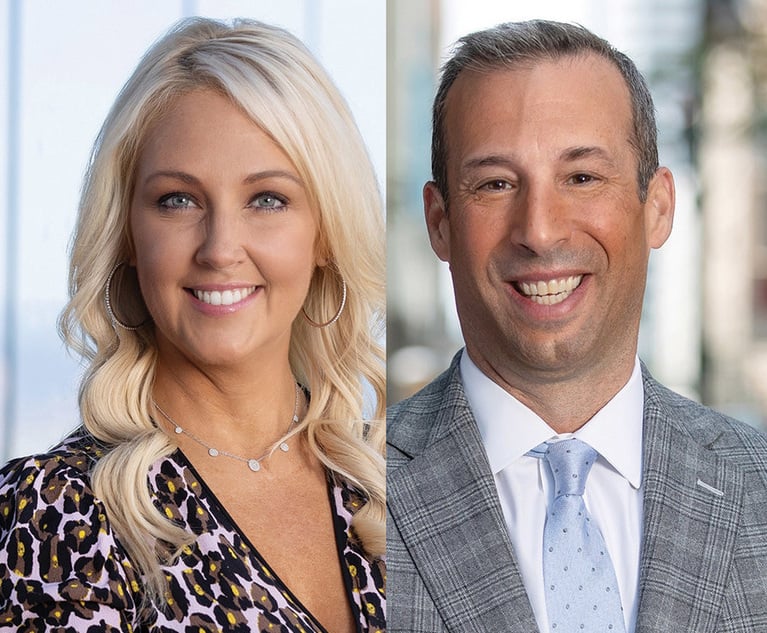The Battle For Talent Is Disrupting The Business Of Law
A shift in the way firms are pursuing laterals is disrupting the market and New York will be the primary battleground.
August 15, 2018 at 01:18 PM
9 minute read
The original version of this story was published on Law.com
 While recent years have seen Silicon Valley, Houston and Boston as the hotbeds for growth focus, the New York legal market is currently, and will continue to be for at least the next 5 years, the most active battleground for lateral movement and disruption, by far. And while this may not be an epiphany for some, the reasons as to why – the macro-changes in the traditional “system” – might be more interesting.
While recent years have seen Silicon Valley, Houston and Boston as the hotbeds for growth focus, the New York legal market is currently, and will continue to be for at least the next 5 years, the most active battleground for lateral movement and disruption, by far. And while this may not be an epiphany for some, the reasons as to why – the macro-changes in the traditional “system” – might be more interesting.
The markets are being disrupted, and NY, in particular, by a dozen or so hyper-aggressive, highly profitable lateral-acquiring firms – generally hailing from outside of NY – that have long since gone on the offensive by actively pursuing, courting and paying huge compensation packages for franchise-grade lawyers. In some cases, this is jarring loose, and enticing to move, majorly valuable (in the way of business, reputational capital and client relationships) partners that would have otherwise never considered moving. And this is where not only financials, but also optics, can get dangerous – see the spotlight that Cravath took when Scott Barshay left, in particular.

Now, of course the fallout adversely affects the firms that lose top-of-the-food-chain rainmakers, but on a grander scale, it also impacts the rest of the market due to the larger-than-life vacuums that are left in the wake. This is the real problem. Left behind the vacating partners are voids that the firms are aggressively trying to backfill with, of course, rainmakers from other firms, which creates a self-perpetuating cycle. Now, the concept of luring laterals away with money isn't new – it's been going on for decades – and of course firms have always sought to backfill those positions. But, it's never been this aggressive, the profile of the moves has never been this high, and the current market represents an escalation in “capillary action” – the movement of high-powered, apex partners upward in the hierarchy – that is creating a tit for tat² scenario and is changing the way that the business of law is being done.
Placing Tit for Tat Under A Microscope
When partners move (and big-money partners, in particular), they may give any number of reasons as to why, but when push comes to shove, the vast majority move for one or more of three reasons: (i) more money, (ii) and/or to stop carrying unproductive partners (this is a “social” aspect, is generally highly underrated by courting firms in the way of motivation, and goes hand in hand with making more money) and/or (iii) anxiety surrounding their firm's strategy and general durability. Let's look at each:
Aggressive payouts: When you are already making $5M and really like your firm, it is one thing to refute the allure of another $1M, but another $5-6M? That's a different animal altogether. This may sound, well, odd, to the average person – “another $1M isn't enough to jar someone loose?” – but in many-to-most instances at the higher levels, no, it is not. Generally speaking, the highest producers are not actually driven by money, which has helped them get to their current station in the first place. They work a lot because they like it; they are (almost exclusively) fiscally responsible; they focus on skill/knowledge/personal development, client service and solving practical problems; and their current financial success is a happy byproduct, not the driver, of their decisions. But, we all have our price, do we not? The current climate is proving this and it is happening more and more.
“Equality” issues: With the roots of all law firms hailing from a partnership culture – i.e., one of equality, contribution and having the same amount of “skin” in the game – it is generally very difficult for firms to openly discuss, much less act upon, what is effectively (and sometimes blatantly) unequal contributions to the firm's bottom line. Further, with (a) the ease of information flow, (b) the (almost uniform) presence of transparent compensation systems, and (c) the relatively recent spike in huge lateral paydays, it is becoming harder for major rainmakers to feel comfortable being paid “in-and-around,” or in some cases equal to, their lesser-contributing partners.
Durability: The movement of big names, firms' inability to backfill those names with commensurate finances and reputational capital, and the resulting optics have caused significant anxiety amongst partners in many firms, including those that once were considered bulletproof.
The combination of these factors has created an environment that is greatly facilitating capillary action in the marketplace. You see, when franchise-grade attorneys vacate a firm, regardless of the firm's patina, there are massive voids left behind – financially, reputationally, culturally, strategically, etc. – that need to be filled. This is doubly so if a firm is not an “elite” player (see figure below). Here, “elite” firms A, B and C have aggressively poached franchise-grade attorneys from “elite” firm D, and “prestigious” firms E, F and G. Left behind are large voids that D, E, F and G will seek to fill, but several factors leave these firms in a recently worse, and even potentially bad, position to do so.

For starters, the firms are newly-damaged goods now that they have lost the franchise-grade attorneys. Finances will certainly take a sizeable dip in the near future, and (very) importantly, the optics of the loss are dramatic. Internally, attorneys are skittish; externally, current clients and potential lateral recruits and clients are concerned – “Why did that partner actually leave?” The result of these factors is a void that is effectively larger than the attorney/s that left, rendering it often impossible to fill with a single attorney, if at all. So, at a minimum the firms must:
- Hunt for more than one attorney;
- Pay (potentially much) more than they ordinarily would have in order to get them;
- Work overtime to perform damage control both within and outside of the firm;
- Deal with the internal challenges of (now) paying lateral attorneys more than they are currently paying existing partners with commensurate business. (This one, in particular, is a doozy for leadership).
The optics of the franchise-grade moves have created, and continue to fertilize, the perception that huge paydays are necessary to get the “best”, and most importantly, the “best” can, indeed, be gotten with enough money! There wasn't really an active lateral market for the Scott Barshays of the world until there was an active market for the Scott Barshays of the world. It's kind of like the 4-minute mile: no one could do it until Roger Bannister and his crew broke it; now the new bar has been set.
So, the leadership of now actively hunting firms follow suit, offering bigger payouts for new laterals that can fill the huge empty shoes. As you might imagine, this pisses off existing partners – “Why is the new person with $9M in business getting paid $1.5M more than me when I have $9M in business AND I've been here 20 years; where the hell is the loyalty?” – further destabilizes the firm's partnership and facilitates outward-facing interest. In the end, this “life cycle” of sorts weakens the firms' appeal to current and potential partners and clients and otherwise leaves the firms vulnerable.
On a lesser scale (usually), those firms that have lost marquee, but not necessarily franchise-grade, partners will pay as close as they can to what is now “market” in order to draw in partners with the biggest books and the most reputational capital possible. And if they manage to make one or more great lateral hires, they inherently create another void to be filled elsewhere. The cycle begins again.
The result is a filtering and capillary effect, of sorts, whereby the best partners of some of the best firms are being drawn upward, or sometimes laterally, in the firm-brand hierarchy, creating vacuums behind them that are then drawing great, but perhaps not franchise-grade partners, upward and away from lesser-branded firms to further their own development. While this potentially benefits the individual lateral/s and the firms, it is also a treadmill that, possibly, some firms will never get off of – and no firm can run forever. It is an aggressive evolution.
Yeah, Yeah, We've Seen This Before…
But why is this market so different from those of the past? For a material number of firms, seeing franchise-grade partners move from what were once considered Kevlar-grade brands is sending waves of concern and anxiety through the partnerships. Suddenly, several points of interest are occupying real estate in the minds of partners: the viability of their firm's strategy; the durability of their institution; the ability of their respective practice to provide the best platform for personal development; etc. “If Cravath can't prevent departures, how the hell can we?” What may have previously been highly latent and subtle concern at one point is now explicit and prompting action. The result is the destabilization of some firms and their strategies, aggressively greasing the wheels of the lateral market.
Is capillary action new to the legal market? No. But, it is greatly magnified at this point in Big Law's timeline and is causing destabilizing shifts in power and money across the entire spectrum. Further, will Cravath live through the loss of Scott Barshay, Eric Schiele and Sandra Goldstein? Almost certainly; though, damn, what a rough stretch for the firm! But, for lesser brands, we shouldn't underestimate the fragility of the law firm structure.

David J. Parnell is an author and speaker, cofounder of the Legal Institute for Forward Thinking and founder of legal search and placement boutique True North Partner Management.
More information on the ALM Intelligence Fellows Program can be found here
This content has been archived. It is available through our partners, LexisNexis® and Bloomberg Law.
To view this content, please continue to their sites.
Not a Lexis Subscriber?
Subscribe Now
Not a Bloomberg Law Subscriber?
Subscribe Now
NOT FOR REPRINT
© 2025 ALM Global, LLC, All Rights Reserved. Request academic re-use from www.copyright.com. All other uses, submit a request to [email protected]. For more information visit Asset & Logo Licensing.
You Might Like
View All
Florida, a Political Epicenter, Is the Site of Brownstein Hyatt's 13th Office
3 minute read
Law Firms Close Southern California Offices Amid Devastating Wildfires
Trending Stories
Who Got The Work
Michael G. Bongiorno, Andrew Scott Dulberg and Elizabeth E. Driscoll from Wilmer Cutler Pickering Hale and Dorr have stepped in to represent Symbotic Inc., an A.I.-enabled technology platform that focuses on increasing supply chain efficiency, and other defendants in a pending shareholder derivative lawsuit. The case, filed Oct. 2 in Massachusetts District Court by the Brown Law Firm on behalf of Stephen Austen, accuses certain officers and directors of misleading investors in regard to Symbotic's potential for margin growth by failing to disclose that the company was not equipped to timely deploy its systems or manage expenses through project delays. The case, assigned to U.S. District Judge Nathaniel M. Gorton, is 1:24-cv-12522, Austen v. Cohen et al.
Who Got The Work
Edmund Polubinski and Marie Killmond of Davis Polk & Wardwell have entered appearances for data platform software development company MongoDB and other defendants in a pending shareholder derivative lawsuit. The action, filed Oct. 7 in New York Southern District Court by the Brown Law Firm, accuses the company's directors and/or officers of falsely expressing confidence in the company’s restructuring of its sales incentive plan and downplaying the severity of decreases in its upfront commitments. The case is 1:24-cv-07594, Roy v. Ittycheria et al.
Who Got The Work
Amy O. Bruchs and Kurt F. Ellison of Michael Best & Friedrich have entered appearances for Epic Systems Corp. in a pending employment discrimination lawsuit. The suit was filed Sept. 7 in Wisconsin Western District Court by Levine Eisberner LLC and Siri & Glimstad on behalf of a project manager who claims that he was wrongfully terminated after applying for a religious exemption to the defendant's COVID-19 vaccine mandate. The case, assigned to U.S. Magistrate Judge Anita Marie Boor, is 3:24-cv-00630, Secker, Nathan v. Epic Systems Corporation.
Who Got The Work
David X. Sullivan, Thomas J. Finn and Gregory A. Hall from McCarter & English have entered appearances for Sunrun Installation Services in a pending civil rights lawsuit. The complaint was filed Sept. 4 in Connecticut District Court by attorney Robert M. Berke on behalf of former employee George Edward Steins, who was arrested and charged with employing an unregistered home improvement salesperson. The complaint alleges that had Sunrun informed the Connecticut Department of Consumer Protection that the plaintiff's employment had ended in 2017 and that he no longer held Sunrun's home improvement contractor license, he would not have been hit with charges, which were dismissed in May 2024. The case, assigned to U.S. District Judge Jeffrey A. Meyer, is 3:24-cv-01423, Steins v. Sunrun, Inc. et al.
Who Got The Work
Greenberg Traurig shareholder Joshua L. Raskin has entered an appearance for boohoo.com UK Ltd. in a pending patent infringement lawsuit. The suit, filed Sept. 3 in Texas Eastern District Court by Rozier Hardt McDonough on behalf of Alto Dynamics, asserts five patents related to an online shopping platform. The case, assigned to U.S. District Judge Rodney Gilstrap, is 2:24-cv-00719, Alto Dynamics, LLC v. boohoo.com UK Limited.
Featured Firms
Law Offices of Gary Martin Hays & Associates, P.C.
(470) 294-1674
Law Offices of Mark E. Salomone
(857) 444-6468
Smith & Hassler
(713) 739-1250












